Gayatri Mantra and it’s meaning (correct) and uses (benefits) | Gayatri mantra meaning word by word | Gayatri mantra benefits | Why is gayatri mantra so powerful | Gayatri mantra benefits in astrology
Namaste friends, how are you doing today? Welcome to #BhagavanBhakthi website / blog.
Bhagavan Lord Sri Krishna (Vishnu) (Rama) (Trivikrama) (Narasimha) and Goddess Rukmini (Lakshimi) (Sita) blessings to you and your family!
In this website / blog, you will always learn about #Hinduism #Sanskrit language.
Also subscribe to my YouTube channel from this link #BhagavanBhakthi to view videos about #Hinduism #Sanskrit language.
Just before going to “Gayatri Mantra and it’s meaning (correct) and uses (benefits) | Gayatri mantra meaning word by word | Gayatri mantra benefits | Why is gayatri mantra so powerful | Gayatri mantra benefits in astrology“, let us know a brief, basic and very important information.
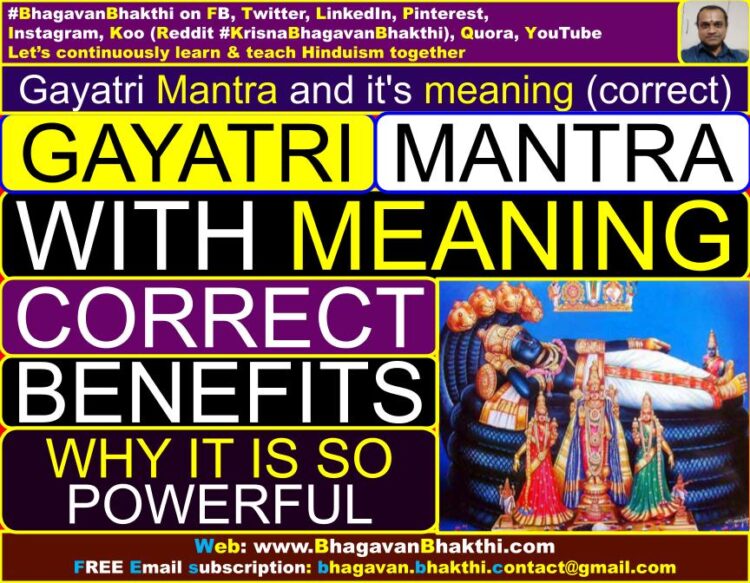
My dear friends, this article explains about the ‘Gayatri Mantra‘ as per Hindu texts (granthas) and not at all as per the own thinking.
Thus, I (The author of this article) urge to the readers to read this post carefully and completely, to understand the correct meaning of the great ‘Gayatri Mantra‘ as per Hindu Texts.
Gayatri meaning – Gayatri = Gaya + Tri = Sing + In all three times = One has to chant (sing) the mantra in all the three times (Morning, Afternoon and Evening).
Gayatri Mantra is without any question is the most well-known Vaidika (Vaidik) mantra in the unlimited universes.
According to sampradaya / tradition, Gayatri Mantra is taught to a young boy (about eight years old approximately) at the time of his Upanayanam (Yagnopaveetham Dhaarana / wearing the Yagnopaveetham / Janeu) or Brahmopadesham.
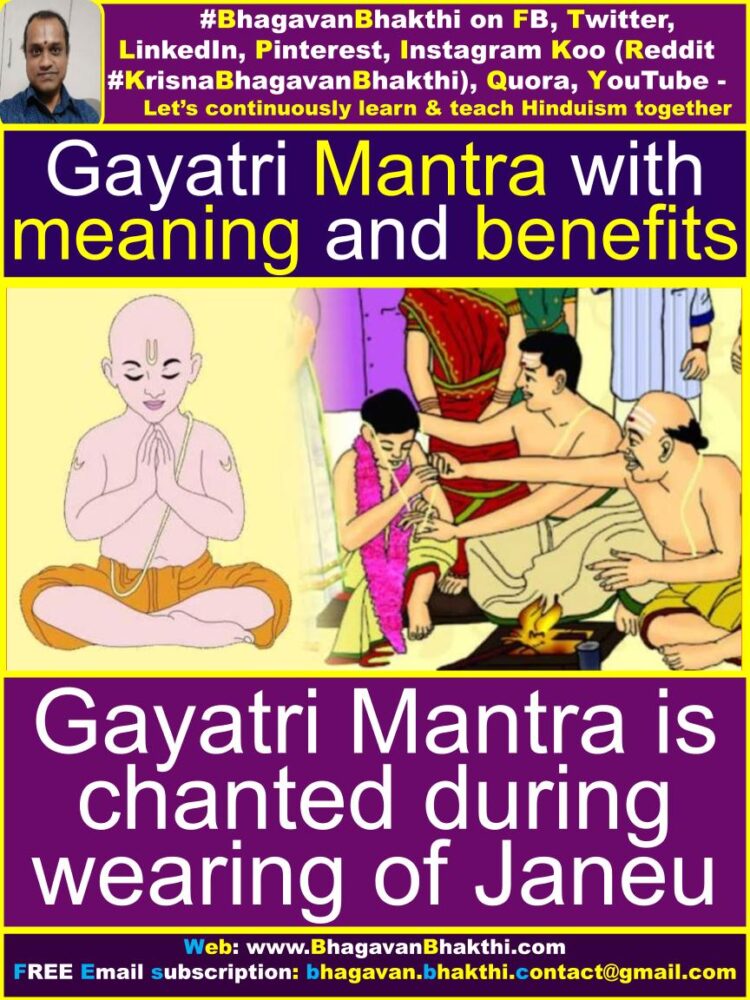
Thus giving that young boy adhikara / authority to do Veda-adhyayana. (Here Veda-Adhyayana means, studying Vedas and other scriptures according to sampradaya / traditional manner).
However, Gayatri Mantra’s popularity goes beyond the narrow limitations of religion, sect or caste. Gayatri Mantra is universally revered as ‘Veda mAta’ (mother of all the Vedas) or the Genesis of all Vedas.
To appreciate this vichara / thought, one needs to understand the inner meaning of the Gayatri Mantra. It is said that everything started with the brahmanda pathana (ब्रह्माण्ड पठन) / cosmic chant ‘ॐ’ / ‘Om’.
This single shabdha / sound ‘ॐ’ / ‘Om’ split into three syllables, that is, ‘अ’ / ‘A’, ‘उ’ / ‘U’, ‘अम’ / ‘M’. These in turn gave rise to the three vyAhrutis, that is, ‘bhU’, ‘bhuvah’, ‘svah’ (or ‘suvah’). These expanded further into the Gayatri mantra, consisting of three lines of 8 syllables each.
From the Gayatri Mantra came the ‘Purusha Sukta‘, later this expanded into the ‘Tri Vedas‘ / three Vedas, that is, Rig Veda, Yajur Veda and Sama Veda.
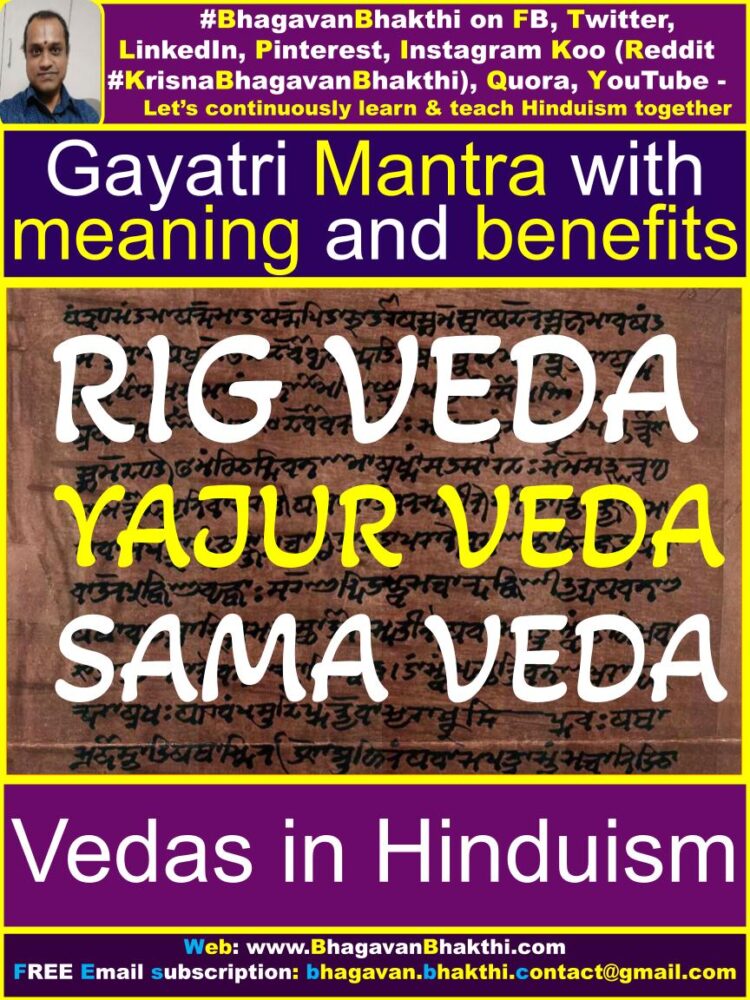
Thus, in a manner of speaking, the Gayatri Mantra is sort of a mid-way point between ‘ॐकार‘ / Omkara and the three Vedas. It is also the essence of all the Vedas.
This is the reason why Gayatri Mantra has been given such a high position amongst all mantras. A perusal of our Shastras / scriptures will reveal that from time immemorial the Gayatri Mantra has been associated with Lord Sri Vishnu (Lord Srimann Narayana).
However, with the advent of the Kali Yuga, this relationship was gradually forgotten and people started associating the mantra with Sri Surya Deva / Sun Demigod.
It was in the twelfth century the avatar of Lord Sri Vayu Deva, that is – Sri Madhvacharya Ji (he is an avatar of Lord Sri Vayu Deva / Sri Mukhya Praana Deva / Sri Hanuman / Sri Bhima), rejuvenated timeless theological concepts that have been enshrined in our Shastras / scriptures.
Before Sri Madhvacharya Ji with the advent of Kali Yuga the people on earth had forgotten the real essence and correct meaning of this great Gayatri Mantra.
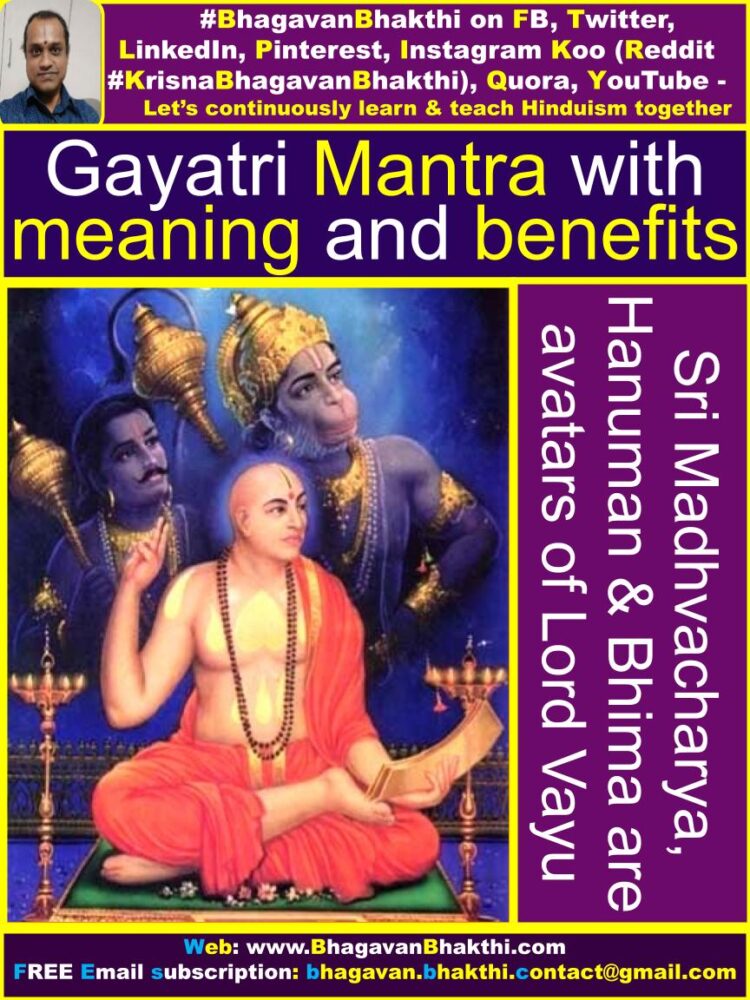
Sri Madhvacharya Ji has left behind unlimited and priceless tattva gnana / philosophical gems for us to savor and benefit from all of those Shastras / scriptures. One of these is Sri Madhvacharya Ji’s commentary on the first forty hymns of the Rig Veda.
Sri Madhvacharya Ji also provided many solid and authoritative references to prove that every sound, syllable, word or phrase or alphabet is actually Lord Sri Vishnu’s name.
Sri Madhvacharya Ji provided an insight into the depth of meaning hidden in the ‘ॐकार’ / Omkara and its association with the great Gayatri Mantra, and the rest of the Vedas.
Gayatri Mantra is as given below:
|| ॐ भूर भुव स्वः तत्सवितुर्वरेण्यं | भर्गो देवस्य धीमहि धियो योनः प्रचोदयात् || (Sanskrit script) – Rigveda 3.62.10
ಓಂ ಭೂರ್ ಭುವ ಸ್ವಃ ತತ್ಸವಿತುರ್ವರೇಣ್ಯಂ | ಭರ್ಗೋ ದೇವಸ್ಯ ಧೀಮಹಿ ಧಿಯೋ ಯೋನಃ ಪ್ರಚೋದಯಾತ್ || (Kannada script) – Rigveda 3.62.10
|| ōṁ bhūr bhuva svaḥ tatsaviturvarēṇyaṁ | bhargō dēvasya dhīmahi dhiyō yōnaḥ pracōdayāt || (English script) – Rigveda 3.62.10
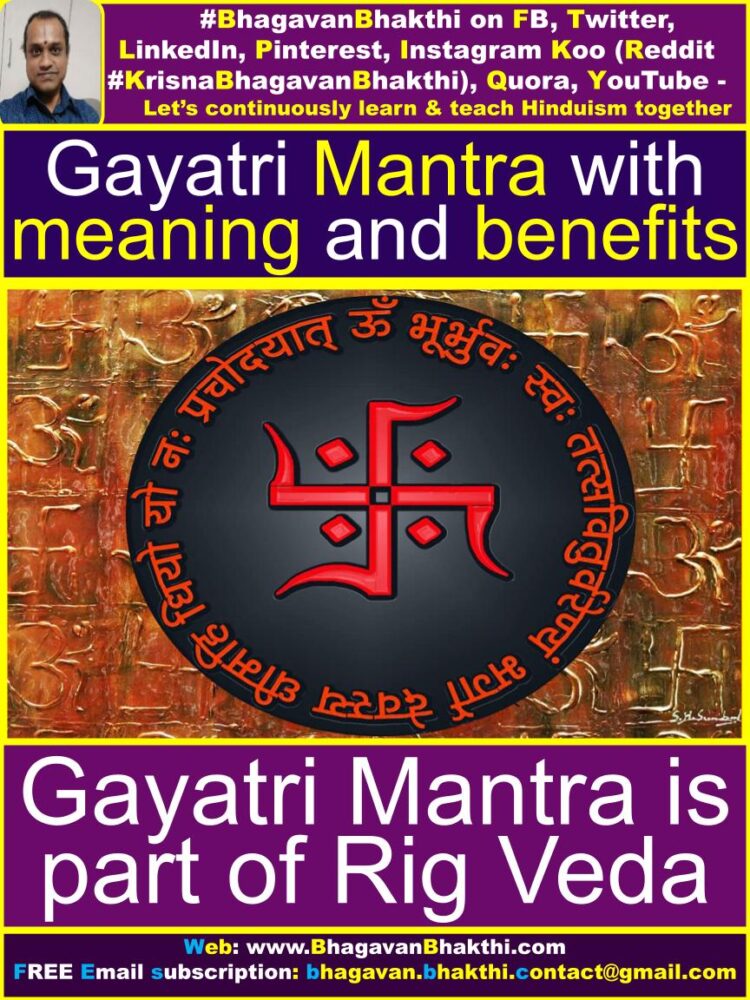
The great Gayatri Mantra has been bestowed as one of the greatest important mantra in Vaidika (Vedic) dharma. Gayatri Mantra has also been termed as Savitri Mantra (the mother of all mantras) or called as Veda-Maata, that is, the maata / mother of all the Vedas.
The meaning of the Gayatria Mantra is as given below:
Gayatri Mantra – Meaning
Bhuhu – Lord Sri Vishnu, who is complete in each and all respects. | Bhuvaha – Someone who is ultimately superior in each and all respects to Goddess Sri Maha Lakshmi Devi. | Svaha – Someone who is filled with all the shubha / auspicious qualities.
Tat – Someone who is sarvavyapi / omnipresent. | Savituhu – Someone who has done the rachana / creation of the multiverses (unlimited universes).
Varenyam – Someone who is prayed by all starting from Goddess Sri Maha Lakshmi Devi, Lord Sri Brahma Deva, Goddess Sri Sarasvati Devi, Lord Sri Rudra Deva (Shiva), Goddess Sri Parvati Devi, Lord Sri Indra Deva, Lord Sri Surya Deva etc. etc. etc.
Bhargo – Someone who sustains the multiverses (unlimited universes). | Devasya – Someone who has greatest qualities (No one is higher or equal to these qualities). | Yaha – Someone who is filled with ananta / unlimited gnana / knowledge and light.
Dhimahi – We all pray to him (Again all to Lord Sri Vishnu, that is, starting from Goddess Sri Maha Lakshmi Devi, Lord Sri Brahma Deva, Goddess Sri Sarasvati Devi, Lord Sri Rudra Deva (Shiva), Goddess Sri Parvati Devi, Lord Sri India Deva, Lord Sri Surya Deva etc. etc. etc.)
Dheeyo yonaha prachodayat – Requesting Bhagavan (God), that is Lord Sri Vishnu / Lord Srimann Narayana to lead us in the Dharma path.
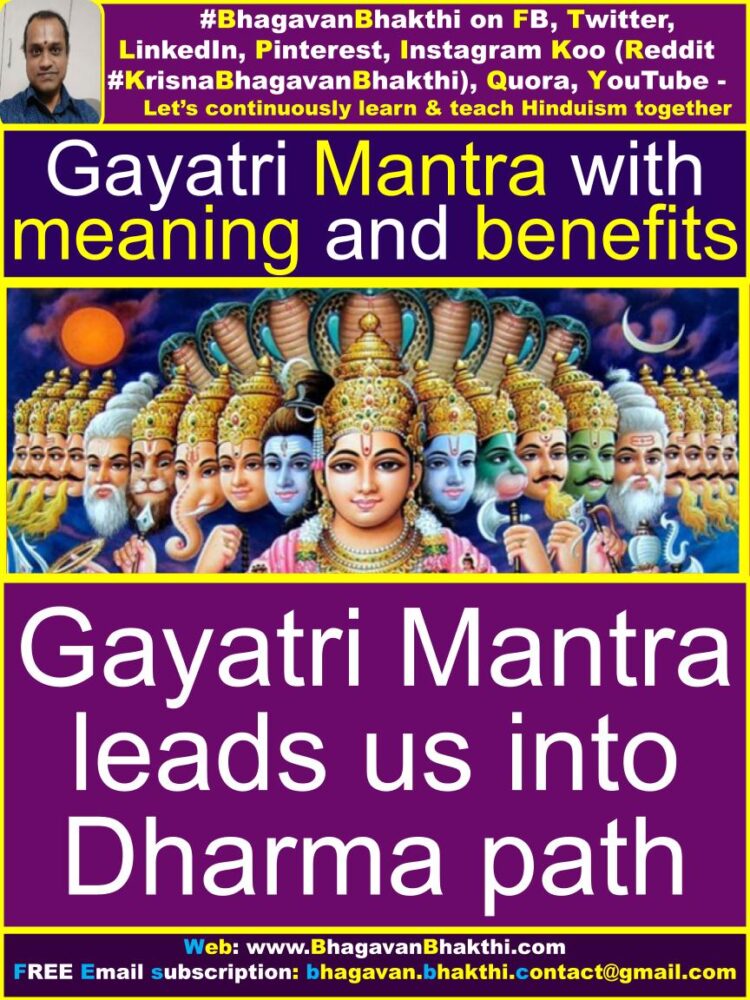
Bhagavan (Sri Vishnu / Sri Narayana), You are sarvavyapi / Omnipresent, sarvashakta / Omnipotent and atyanta bhalashaali / Almighty. Bhagavan (You) are all Jyoti / Light. Bhagavan (You) are all gnana / knowledge and ananda / bliss.
Bhagavan (You) are nashaka / destroyer of bhaya / fear; Bhagavan (You) are rachana kaaraka / creator of this multiverses (unlimited universes), Bhagavan (You) are the mahantam (महानतम) / greatest of all. We bow and meditate upon your jyoti / light. Bhagavan (You) guide our buddhi / intellect in the right path.
Gayatri Mantra’s scientific importance is as given below:
The great Gayatri Mantra, however, has a great scientific importance too, which somehow got lost in the literary sampradaya / tradition.
The adhunika / modern खगोल भौतिक शास्त्र / astrophysics and खगोल विज्ञान / astronomy explains us that – our Galaxy called Akasha Ganga or Milky Way contains approximately 1,00,000 million nakshatras / stars.
These each nakshatra / star is like our Surya / Sun having its own graha mandala / planetary system.
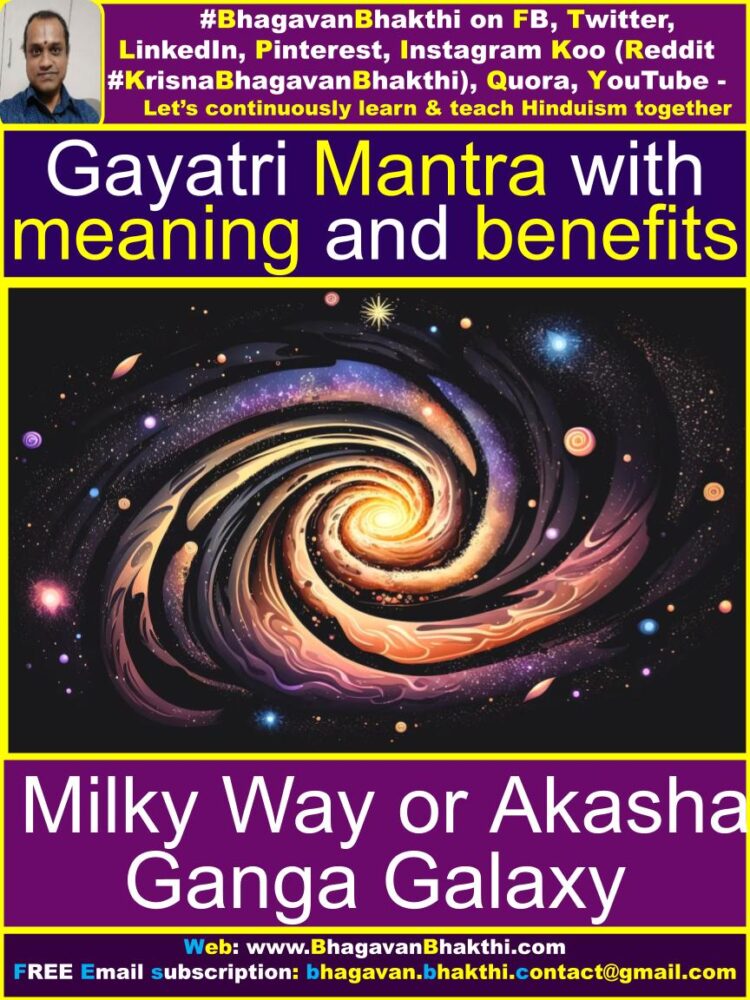
Most of us may be aware that the Chandra / moon moves around the bhoomi / earth and the bhoomi / earth moves around the Surya / sun along with the moon and also all the grahas / planets around the Surya / sun.
We also know that each and every particle / bodies revolves around at its own axis as well. Our Surya / sun along with its whole family takes one round of the galactic center in 22.5 crore years.
We should know that, all galaxies including our own Akasha Ganga / Milky Way are moving away at a very high speed of 20,000 miles per second.
Alternative scientific meaning of the Gayatri Mantra step-by-step is as given below:
1. Om bhur bhuvah swah : Bhur the earth, bhuvah the grahas / planets (of the solar family), swah the upper planets and galaxy. We may have observed that, when a domestic fan with a velocity of 900 RPM (rotations Per minute) moves, it makes some noise.
Then, we can easily imagine, what a huge noise would be created when the galaxies move with a speed of 20,000 miles per second. This is, what this portion of the Gayatri Mantra explains is that the sound produced due to the fast-moving earth, planets, galaxies, universes is ॐ / Om.
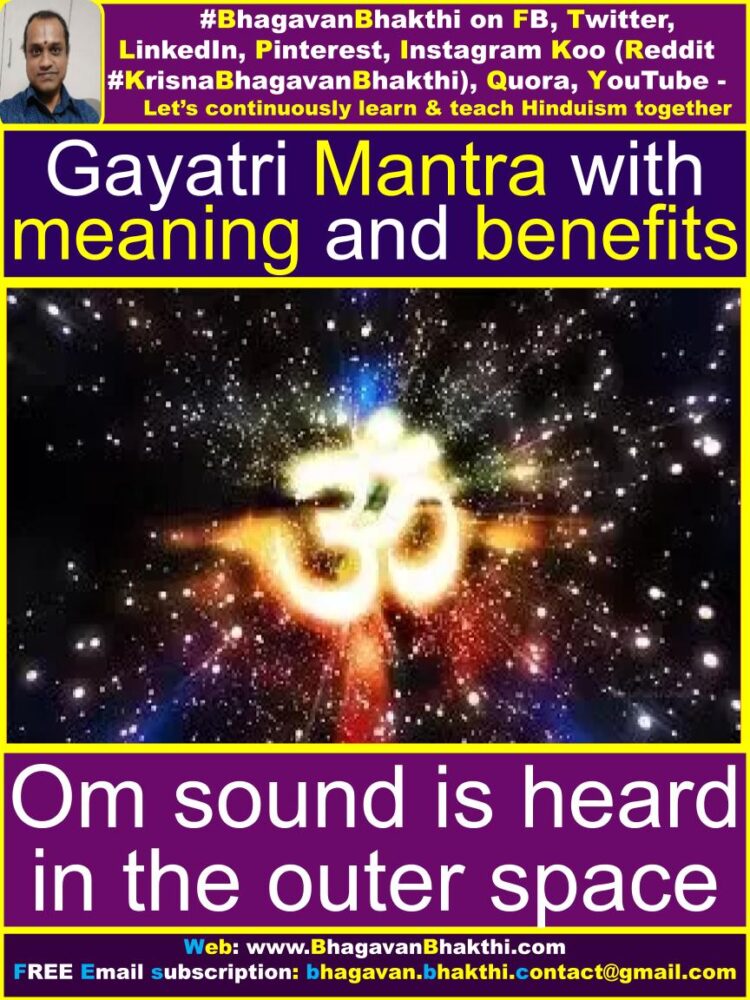
The sound was heard during meditation by Brahmarishi Vishvamitra, who mentioned it to his other Rishis / sages.
Thus all the Rishis / sages, then unanimously decided to call this sound ॐ / Om by the name of Vishnu Bhagavan / Ishvara / God.
Because this sound is available in all the three worlds in all the three periods of time. Hence this sound was set as a permanent sound. Therefore, it was the first ever-revolutionary idea to identify formless Bhagavan / God with a specific form called upaadhi.
Until that time, most of the people recognized Bhagavan / God as formless and nobody was prepared to accept this reality. In Srimad Bhagavad Gita also, it is said, “ॐ इति एकाक्षरं ब्रह्मा” / “Omiti ekaksharam Brahma”:
This means, the name of the Sarvottama / Supreme is ॐ / Om, which contains only one syllable (8/12). This sound ॐ / Om heard during samadhi was called by all the seers as नाद ब्रह्मा / naada-Brahma, a very huge noise.
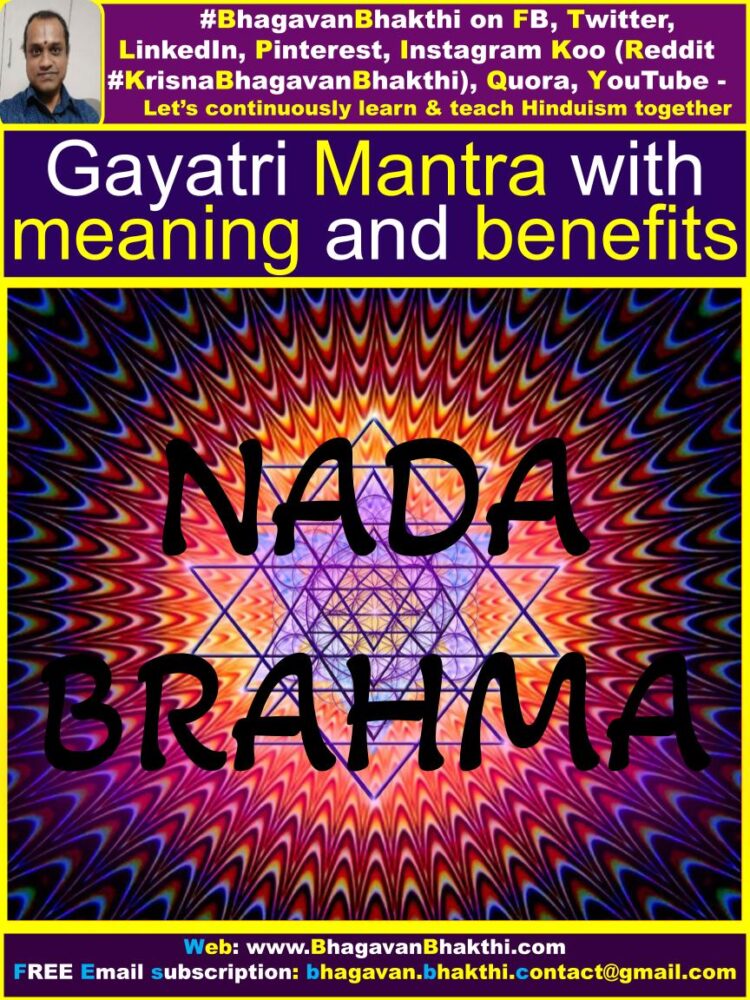
But this was a noise that is normally beyond a specific amplitude and limits of decibels was suited to human hearing. Hence all the rishis called this sound as ‘Udgita‘ musical sound of the above, i.e., Heaven.
Rishis also noticed that the infinite mass of galaxies moving with a speed of 20,000 miles / second was generating a kinetic energy = 1/2MV2 and this was balancing the total energy consumption of the cosmos.
Hence all Rishis named it as ‘Pranavah‘, which means the body (vapu) or storehouse of energy (prana).
2. Tat savitur varenyam : ‘Tat‘ means that (Bhagavan / God), savitur the Lord Sri Surya Deva / sun (star), varenyam means worthy of bowing down with bhakti / devotee / respect.
Once the appearance of a person along with his / her name is known to us, we may be able to locate that specific person. Hence the two titles (upaadhi) provide the solid ground to identify the formless Bhagavan / God, Brahmarishi Vishvamitra suggested.
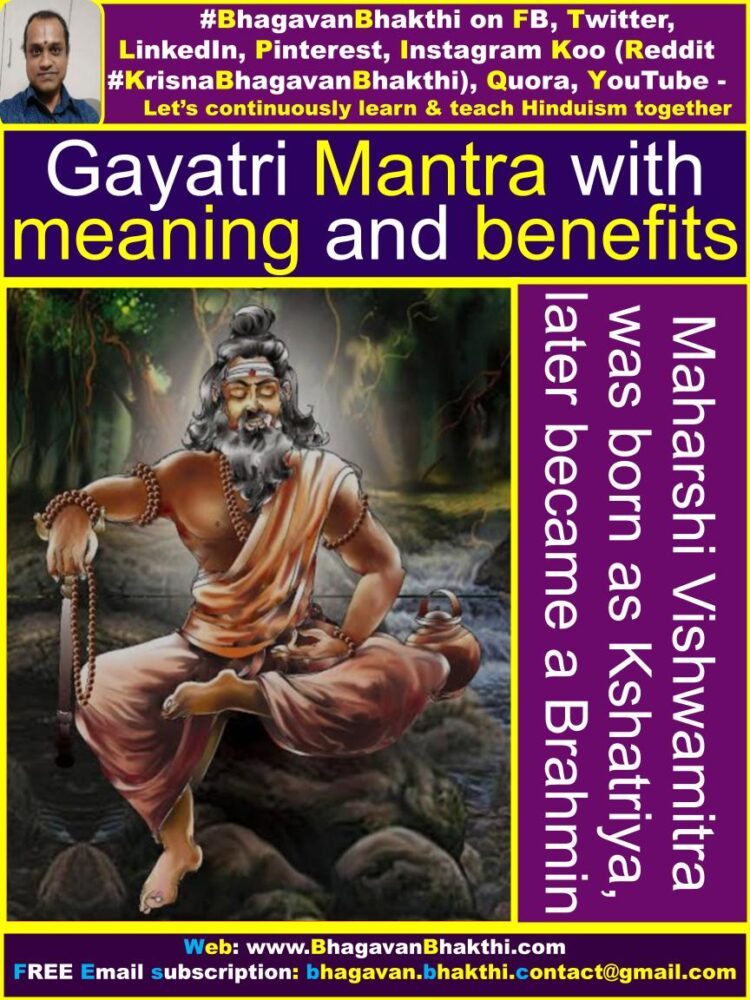
Brahmarishi Vishwamitra also told us that we could know (realize) the unknowable formless God through the known factors, viz., sound Om and light of Suns (stars).
A Mathematician can easily solve an equation x3+y5=4; if x=7; then y can be easily found out. An Engineer can measure the width of a river even by standing at the riverbank just by drawing a triangle.
Similarly, the scientific method was suggested by Brahmarishi Vishvamitra in the mantra in the next portion is as give below:
3. Bhargo devasya dheemahi : Bhargo means the jyoti / light, devasya means of the deity, dheemahi we should meditate upon.
The Brahmarishi Vishwamitra instructs us to meditate upon the available form (light of suns) to discover the formless Creator Bhagavan / God. Also Brahmarishi Vishwamitra wants us to do Japam / chant of the word ॐ / Om (this is understood in the Mantra).
This is how the Brahmarishi Vishwamitra wants us to proceed.
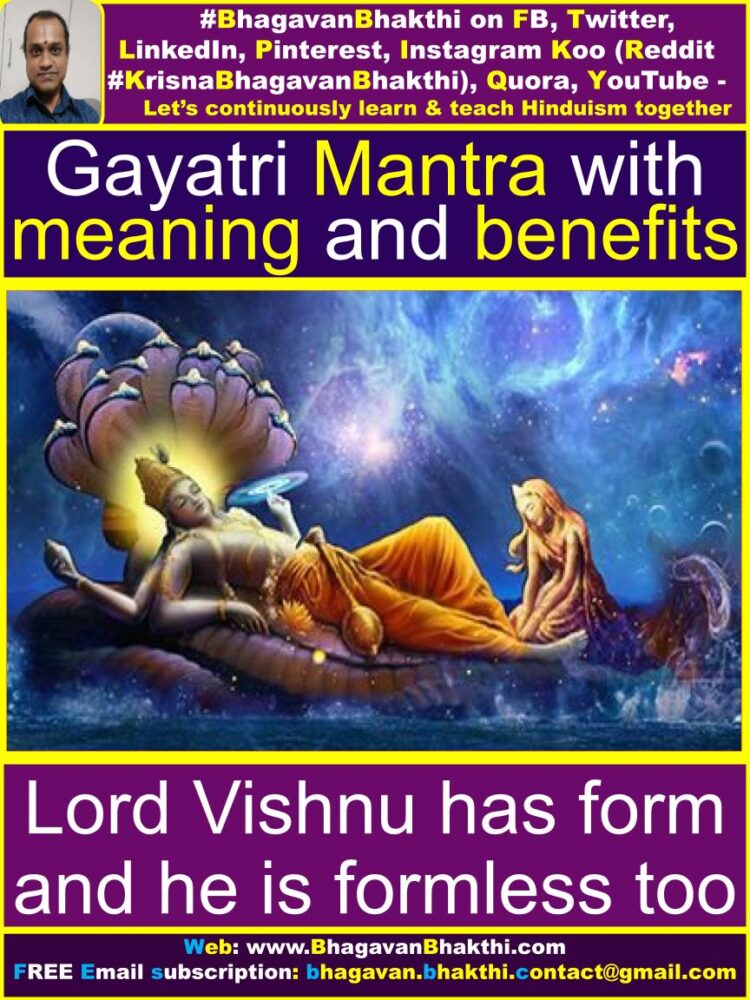
But there is a great problem to realize it, as the human mind is having so many miscellaneous things, and almost most of the time will be restless that without the grace of the Sarvottama / Supreme (Brahma / Bhagavan Sri Vishnu) it cannot be controlled.
Hence Brahmarishi Vishwamitra suggests the way to pray upon the Sarvottama / Supreme (Brahma / Bhagavan Sri Vishnu) Bhagavan / God as give below:
4. Dhiyo yo nah prachodayat : Dhiyo (buddhi shakti / intellect), yo (who), nah (we all), prachodayat (guide us towards the right direction). O Brahma / Bhagavan! Show our buddhi shakti / intellect on the right path.

Scientific interpretation of the Gayatri Mantra is as given here: The earth (bhur), the grahas / planets (bhuvah), and the upper and the galaxies (swah) are moving at a very high speed.
During this movement the sound produced is called as ॐ / Om, (the name of formless Bhagavan / God). That Bhagavan / God (tat), who manifests Himself in the form of jyoti / light of unlimited Suryas / Suns (savitur) is worthy of bowing down with bhakti (devotion) and respect (varenyam).
Thus we should all meditate (dheemahi) upon the jyoti / light (bhargo) of that deity (devasya) and also should be chanting ॐ / Om. May He (yo) guide us in the right path (prachodayat) our (nah) buddhi shakti / intellect dhiyo.

The important points hinted in the Gayatri Mantra are as given below:
A. The total sum of kinetic energy generated by the movement of galaxies acts as an umbrella and balances the total energy consumption of the cosmos. Hence it was named as the Pranavah (body of energy). This is equal to 1/2MV2 (Here MV = Mass of galaxies x velocity).
B. Understanding the great importance of the syllable ॐ / OM, the other recently born religions adopted this word with a slight change in pronunciation, that is, as Amen or Ameen.
C. Bhagavan / God could be realized through the saguna (with the qualities), upaasana (method), i.e.
(a) by doing naama smarana / chanting the name of the sarvottama / supreme Bhagavan Sri Vishnu as ॐ / OM.
(b) by meditating upon the jyoti / light emitted by stars (unlimited Surya / Suns).
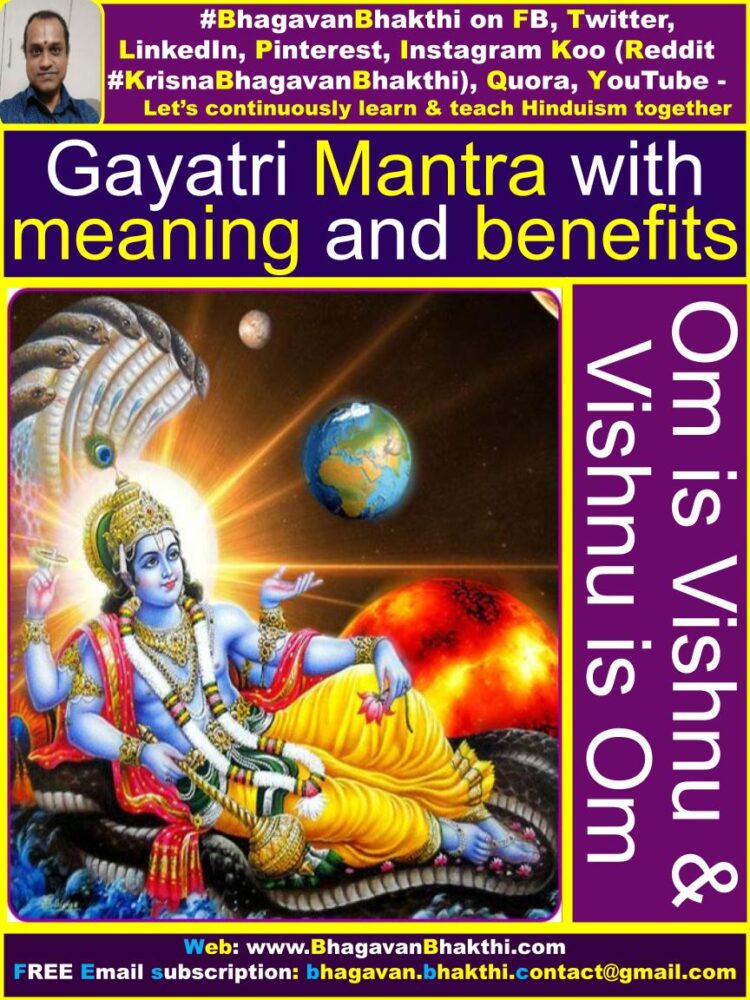
Uses (Benefits) of chanting Gayatri Mantra are as given below:
1. The real use of chanting Gayatri Mantra benefits us, when we does it on a regular and persistently basis for at least for a month.
2. One should understand the meaning of the Gayatri Mantra that one recites. Then itself we will be able to earn the real benefits of the Gayatri Mantra.
This is just like a student writing the examination. If he / she writes the exams by understanding the concept of the subject, then for him / her the benefits will be more and it will be easy to write in the examination also.
3. Knowing the meaning of what we chant gives us to know the significance of the Gayatia Mantra and generates the interest in pursuing the same in a persistent manner and in the long term.
4. One will definitely understands the use of Gayatri Mantra and will also have the stress-free life and efficiency in all the quarters.

5. If one does not get the opportunity to attend pravachanas (discourses) or regular classes (patha / lesson), one should use the books and modern technology to obtain the knowledge on spiritual matters with the help of right Guru. Thus we can get more benefits.
6. With the chanting of Gayatri Mantra, one’s mind and body will be ready to gather multiple knowledge on various domains.
Gayatri Mantra’s 24 akshara roopas (forms) of Lord Sri Vishnu is as given below:
1. tat – Keshava (केशव), 2. sa – Narayana (नारायण), 3. vi – Madhava (माधव), 4. tu – Govinda (गोविन्द), 5. va – Vishnu (विष्णु), 6. rE – Madhusudana (मधुसूदन), 7. Ni – Trivikrama (त्रिविक्रम), 8. yaM – Vamana (वामन), 9. bhar – Sridhara (श्रीधर),
10. ga – Hrushikesha (Hrishikesh) (हृषीकेश), 11. dE – Padmanabha (पद्मनाभ), 12. va – Damodara (दामोदर), 13. sya – Vasudeva (वासुदेव), 14. dhI – Sankarshana (संकर्षन), 15. ma – Pradyumna (प्रद्युम्न), 16. hi – Aniruddha (अनिरुद्ध),
17. dhi – Purushottama (पुरुषोत्तम), 18. yO – Adhokshaja (अधोक्षजा), 19. ya – Narasimha (नरसिंह), 20. na – Achyuta (अच्युत), 21. pra – Janardana (जनार्दन), 22. chO – Upendra (उपेन्द्र), 23. da – Hari (हरि), 24. yaat – Krishna (कृष्ण).
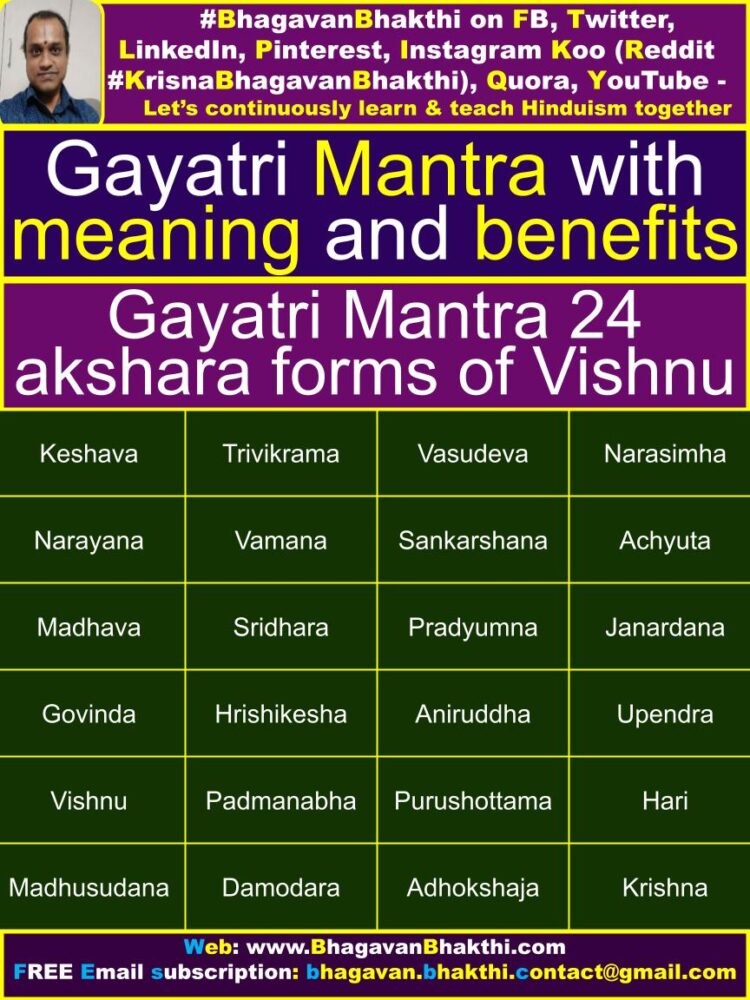
Above explanation is given as per my (This article author) knowledge. It should be noted that, the above explanation is limited to my knowledge about the great Gayatri Mantra. Gayatri Mantra has infinite amount of explanation beyond everybody’s imagination.
More information will be added to this post on regular basis. Please visit after some time to get more updated information about this post and other posts of this website.
To watch videos on #Hinduism #Sanskrit language, SUBSCRIBE to my YouTube channel from this below link:
#BhagavanBhakthi YouTube channel
To know about “What is the Om Namo Narayanaya – mantra“, please visit the below link:
What is the Om Namo Narayanaya mantra and it’s meaning
To know about Lord Vishnu related posts, please visit the below link:
To know about Lord Krishna related posts, please visit the below link:
More information will be added to this. Please visit after some time.
To know stotras of Bhagavan Sri Vishnu, Rama, Krishna and other Devatas, please visit the below link:
Stotras of Bhagavan Sri Vishnu, Rama, Krishna and other Devatas
To know “Goddess Sri Lakshmi Ashtottara Shata namavali (108 names) with meaning in Sanskrit, Kannada and English languages”, visit the below link:
To know “Goddess Lakshmi Shlokas (stotras) with meaning in Sanskrit, Kannada and English”, visit the below link:
Goddess Lakshmi Shlokas (stotras) with meaning in Sanskrit, Kannada and English
To know “What are Goddess Lakshmi names in different avatars along with Lord Hari’s names”, visit the below link:
What are Goddess Lakshmi names in different avatars along with Lord Hari’s names
Dear friends, if you need any clarifications about this post, kindly let me know, I will definitely try to answer all of them.
Also your one LIKE, one COMMENT, One Share, one SUBSCRIPTION is highly important.
This will help to know the quality of this content and also it will be helpful to know if any improvements is required for the content.
If you feel this content is useful to you and has helped you to improve your knowledge, kindly share this with your well-wishers.
Because “SHARING MEANS CARING”.
To receive FREE EMAIL SUBSCRIPTION about #BhagavanBhakthi, you can send an email to bhagavan.bhakthi.contact@gmail.com from your email ID.
NAMASTE!
Sri Gurubhyo Namaha
Sri Krishnaaya Namaha
Sri Krishnaarpanamastu
Share in Social Media
Wonderful article.
Can you also help how to chant Gayayri mantra ?
Starting from aachamana and deha shuddi?
Dear Chethan Ji,
Thanks for your wonderful comments
I suggest you to find a true Vaishnava Guru for this.
Shubhamastu!
Thanks for sharing. I read many of your blog posts, cool, your blog is very good.